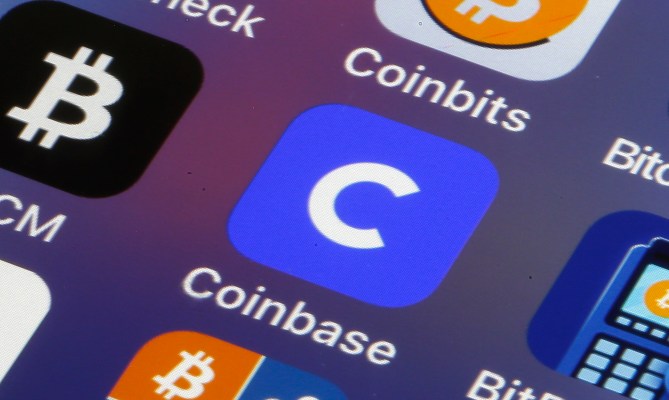At long last, Coinbase’s NFT push came to the market this week.
The U.S. cryptocurrency trading giant’s entry into the market for non-fungible tokens has been a long time coming and lands at an important time for the public company. Shares of Coinbase are trading near all-time lows today ahead of its earnings that will land in early May.
Coinbase has proven that it can build a large, profitable business by helping both individuals and institutions buy, sell and stake crypto. But as its revenues — and, therefore, net income — oscillate with the macro health of the crypto market itself, the company has taken on the valuation profile of a bank more than a technology company.
Indeed, if we observe the company’s Q4 net revenues of $2.49 billion, and we compare an annualized version of that number against Coinbase’s current market valuation of $36.3 billion, we can see that the company is trading for a revenue multiple of less than 4x.
The NFT effort from Coinbase, then, is at once its entry into a market that already has an incumbent — the valuable and popular OpenSea NFT platform — and a shot at a new vein of growth to tap. Growth that could help Coinbase move its valuation, and resulting multiples, closer to the range that it enjoyed while private.
Sadly, data on the Coinbase NFT push is de minimis today. This is not a huge surprise, really, as the new service from the former unicorn is well, new. So instead of trying to parse what appear to be the first dribs and drabs of numbers from third-party analytics services, let’s ask a few questions. Today we’re outlining our three top head-scratchers concerning the new Coinbase NFT project.
In basic terms, we want to know how fast Coinbase’s NFT marketplace can scale in the near term, its potential economic profile, and, finally, its long-term growth prospects. We’ll take them in order. Let’s have some fun!
How fast can Coinbase scale NFT volume?
Over the next few weeks, we’ll be curious to see how much volume there is in terms of total trades, as well as the value of those trades driven by Coinbase’s NFT marketplace.
The company has an enormous waitlist and has a simply massive user base to shuttle into its new product. How well that waitlist converts into active users, and then activity, is a critical question. And after the waitlist is chewed through, the fraction of Coinbase that heads over to the NFT product will help us determine volume growth at the company in the immediate future.
So far data is limited, and, frankly, incomplete. So we don’t know much today, but the strength of Coinbase’s start in the NFT game will perhaps give us a vibe for how quickly it may scale volume over the next few quarters, a key period for the company if it wants to regain some of the value it lost over the last few months. Naturally, however, volume is just one part of the trading revenue equation. The other is fees.
How strong do the economics of Coinbase’s NFT push look?
In the long term? Good. In the near term? Weird!
Here’s an excerpt from our coverage of the Coinbase NFT launch from earlier in the week:
There will also be no transaction fees on NFTs on its marketplace “for a limited time.” Over time, the fee will increase, but will be a “low single-digit fee,” Sanchan Saxena, vice president of product at Coinbase, said during the meeting. Users can either use a Coinbase wallet or any self-custody wallet they own to trade NFTs on the platform.
By charging no fees to start, Coinbase is flexing the fact that it is incredibly wealthy and profitable. It can afford to forgo fees to encourage volume. Once its marketplace reaches a healthy level of supply and demand, it can begin to extract revenues.
Doing so could prove to be big business. OpenSea has demonstrated that it is possible to extract several percentage points of the value of NFT trades as revenue, meaning that for Coinbase, volume is the key question to start. So long as it can obtain volume, the market will likely bear an OpenSea-style fee structure. Which, as we have learned, is very lucrative.
There are some problems with that sunny outlook. First, OpenSea could fire back with a fee cut. Second, Coinbase may need to operate at a lower fee rate than OpenSea for some time to earn enough volume to warrant a higher cut. There’s also overall fee pressure in the crypto market, which could lower the long-term revenue possible from the NFT trading business.
Does Coinbase enter the NFT market, or accelerate it?
Thinking longer term, we’re curious whether Coinbase will have a Coinbase-style effect on the NFT industry. Coinbase has proven to be a key way of getting folks into the crypto world, bringing things like staking to millions of users who might have otherwise not known about the newer, more lucrative, and risky parts of the crypto market. This has grown the total crypto user base, especially in the United States.
If Coinbase can bring similar easy access and wider attention to the NFT market, it could grow the whole pie. That would be salubrious for Coinbase, winsome for OpenSea to some degree and fine fettle for crypto more broadly. But if Coinbase merely joins the NFT market, and doesn’t fundamentally expand it, the overall revenue profile that its new product could generate in time will be smaller.
Investors are weighing the above, and I expect NFTs to be discussed during the upcoming Coinbase earnings call on May 3. Strap in; it’s going to be lit. Or at least as lit as earnings season gets.
